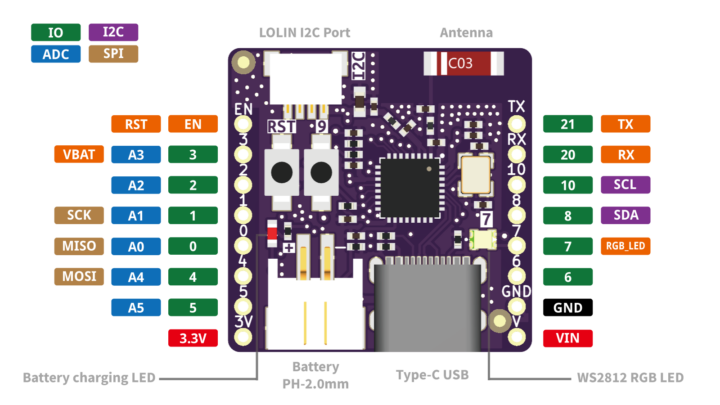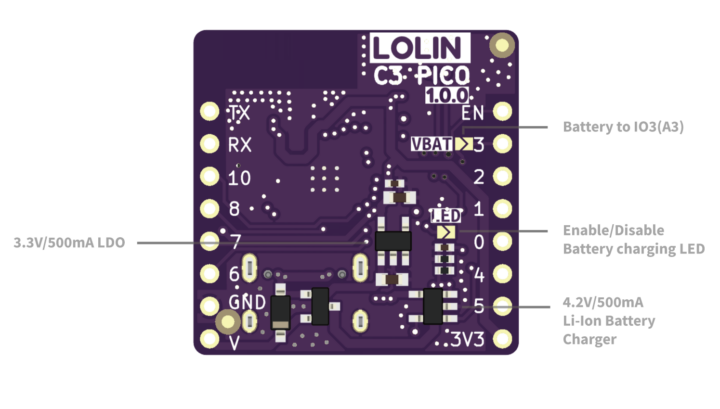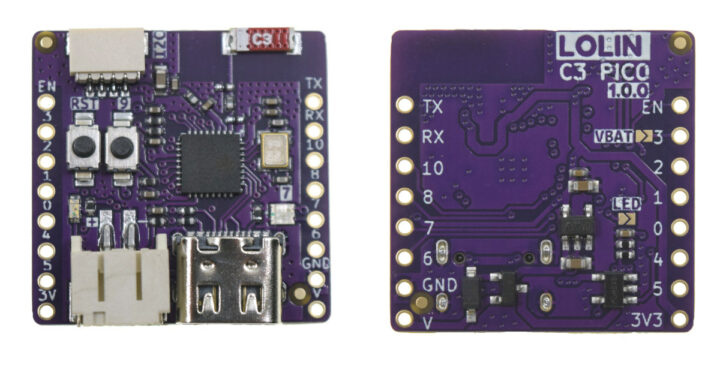LOLIN C3 Pico is a tiny (25.4×25.4mm) ESP32-C3 RISC-V board with 2.4 GHz WiFi and Bluetooth Low Energy connectivity, a few I/Os, and LiPo battery support including charging circuitry.
I tend to like Wemos/LOLIN boards, because of their small form factor, support for equally tiny shields, and low price. The LOLIN C3 Pico is no exception, and even adds a few features such as an RGB LED, an I2C connector, and support for battery power and charging.
LOLIN C3 Pico specifications:
- SoC – Espressif Systems ESP32-C3FH4 single-core 32-bit RISC-V (RV32IMC) microcontroller up to 160 MHz with 400 KB SRAM, 4MB Flash
- Connectivity – 2.4 GHz WiFi 4 and Bluetooth 5.0 LE (in SoC)
- Expansion headers
- 2x 8-pin headers with up to 12x GPIO, ADC, I2C, SPI, UART (3.3V I/O voltage)
- LOLIN I2C port
- USB – 1x Type-C USB for 5V power and programming
- Misc – Reset button and user button, RGB LED
- Power Supply
- 5V via USB-C port or VIN pin
- 2-pin JST connector for LiPo battery and 500mA charging support
- Dimensions – 25.4 x 25.4 mm
- Weight – 2.6 grams


The board ships with MicroPython firmware, but also support Arduino, CircuitPython, and ESP-IDF programming. Documentation and basic instructions to get started can be found on the wiki.
What’s interesting is that the LOLIN C3 Pico is a smaller version of the LOLIN C3 Mini introduced in Q1 2022 with all the same features, but adding battery support, an I2C connector (Qwicc compatible?), and an RGB LED. This was partially achieved by replacing the PCB antenna with a more compact ceramic antenna.
The main downside compared to the C3 Mini is the price with the LOLIN C3 Pico going for $5.00 plus shipping, and the previous board is usually sold for $4.10. However, they must be getting rid of existing stock with the LOLIN C3 Mini board being offered for just $2.50 plus shipping (or $2.78 in total to Thailand). $5 also happen to be the price for the even smaller XIAO ESP32C3 board with similar features as the LOLIN C3 Pico, but two fewer I/Os, and an external antenna.

Jean-Luc started CNX Software in 2010 as a part-time endeavor, before quitting his job as a software engineering manager, and starting to write daily news, and reviews full time later in 2011.
Support CNX Software! Donate via cryptocurrencies, become a Patron on Patreon, or purchase goods on Amazon or Aliexpress. We also use affiliate links in articles to earn commissions if you make a purchase after clicking on those links.






The I2C socket is not QWIIC alas, it’s Lolin’s own pre-QWICC pinout that they’ve used on various other of their boards.
I’ve designed a bunch of lolin-stacking-pinout boards that do use QWIIC
Does anybody know if they used the ME6211C33 LDO with its >40 uA Iq again?
Yes, they did. The schematics are publicly available right there in the wiki.
That is plain stupid. Why they use a regulator with an order or magnitude worse supply current than the micro in deep sleep?! Perhaps so that the battery had be charged 5x more often? You can buy a 500mA capable LDO for the same price as ME6211 with Iq only 1.8 uA.
Such an incompetent desing engineer should have been dumped.
And which LDO with an Iq of 1.8uA are you thinking of as there are trade offs with any IC?
There is no metal RF shield on either the C3 Mini or C3 Pico modules. So do these modules qualify as pre-approved by the FCC for-example? If I use one in my product do I need to have the entire product tested and approved? I am not seeing an FCC ID on either board, front side or back side. Does having the ESP32-C3 chip on the board connected to a pre-approved on-board SMT chip antenna qualify the whole board as pre-approved? I do not think so.
I’m not a lawyer or RF-design expert or anything and even I know that it’s the entire RF-circuitry that needs to be approved, not just the antenna. Going with the bare components without an RF-shield instead of the premade modules with shields is a cost-cutting measure, not because the shield is redundant, so yes, you’d have to have the product certified yourself and I doubt you’d get it through the process without any shielding.
See e.g. https://www.sparkfun.com/news/3123 — “One of the requirements for FCC approval is RF shielding for intentional radiators. In other words, if your thing does wireless it needs a metal ‘can’ over the top of the design to reduce the amount of spurious RF noise.”
As far as I can see – some things to note about both the WEMOS/LOLIN ESP32-C3 Mini and the newer ESP32-C3 Pico modules. The ESP32-C3 mini has no on-board power path switching or battery charging. The ESP32-C3 Pico supports on-board battery charging with a PMOS transistor plus Schottky diode primary power-path switch, plus a TPOWER TP4054 charge controller chip.[1] But the ESP32-C3 Pico has no on-module battery protection, which usually appears in the form of a DW01A/B protection controller chip [2] and a 8205A dual power-path NMOS switch.[3][4] Therefore with the ESP32-C3 Pico I suggest you ONLY use rechargeable cells with BUILT-IN battery protection circuitry.
Corrections welcome…
The ESP32-C3 Pico is meant to be primarily used with the li-ion pouch cells, which use the JST-PH connector. Those pouches also almost always contain a protection IC, so including that on the PCB would’ve been redundant.
Fore some longer time i am searching for a risc-v device with a stronger 3.3Volt rail. This one have again just 500mA on 3.3Volt.
Did someone know a device with at least the capability of powering 1.5A on 3.3V rail?
A different solution would be the capability to run on 5V and on 3.3V with no conversation. Then VIN should be equal the SPI voltage and i can controll the max amp of the device by its power supply instead the build in dcdc-chip.
It would be pretty easy to whip up a design with a switching DC-to-DC converter capable of delivering higher currents — a couple of hours of work, order the PCBs, wait for them to arrive, solder the components and enjoy.
Another option would be to use a separate 3.3V power supply instead of the 500mA LDO on the PCB. That way it’d be entirely up to your tastes as to what you wish to use as the power supply and how much current you wish for it to handle.
They are selling Lolin Mini v1.0. cheaper in the Aliexpress. Unfortunately in this Lolin’s 1st ESP32-C3 board has a design flaw in Rf circuitry (as was in the 1st Lilygo C3 board), which limits wifi usage.
Lolin released second version of their C3 board with Rf design corrected as did Lilygo earlier. When you see the red ceramic Wifi antenna, those boards are usually the working ones.
Other than putting the ESP32-C3 into deep sleep mode, is there a way to physically lower the power/ power off the device when the battery is connected?